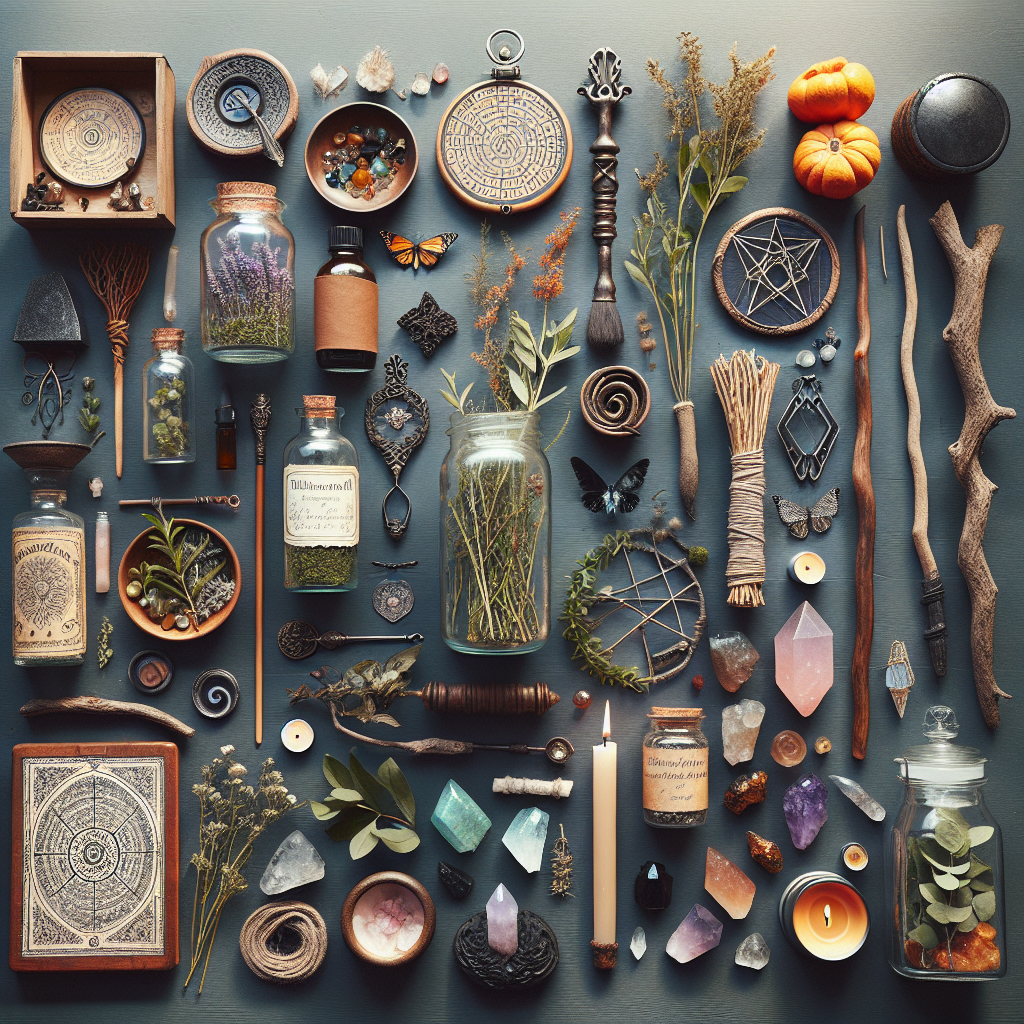As an Amazon Associate I earn from qualifying purchases.

Many of the tools used in witchcraft have roots in natural elements and everyday objects, making the practice inherently accessible to those on a budget. Historically, practitioners of witchcraft have often crafted their own tools from materials readily available to them, as witchcraft is deeply personal and individualized. Creating your own tools not only saves money but also adds a layer of personal connection and power to your practice.
Easing into the world of DIY witchcraft, one might begin with items like candles and herbs. With candles being a staple in many rituals, you can make your own by melting down leftover wax and setting new wicks. This can be an economical way to ensure you always have candles for your practice. Meanwhile, growing your own herbs for spells and rituals connects you to the earth's cycle and imbues your work with the energy of your own care and attention.
Another popular tool is the wand, an extension of the practitioner's will. Instead of purchasing an expensive, ornate wand, a simple branch found on the ground can be carved, sanded, or dressed up with crystals, strings, or carvings to create a personalized magical implement. In doing so, you imbue the wand with your personal energy and intention, enhancing its significance in your craft.
The altar is the heart of many practitioners' sacred space, and constructing one doesn't need to be costly. A small table or shelf, a cloth, or even a space on the ground can serve as a foundation. Household items like bowls, cups, and plates can be designated as sacred objects to hold offerings, water, or salt. Adding stones, crystals, or images to your altar can be as simple as finding items that resonate with you personally, rather than sourcing expensive, store-brought items.
An athame, a ceremonial blade, is traditionally used to direct energy rather than for cutting. A simple knife that feels right in your hand, which you consecrate for ritual use only, can work just as effectively as more elaborate, costly blades. Likewise, a piece of clear glass can replace a crystal ball for scrying, and you can fashion a pendulum from a favorite necklace or a string with a weighted end.
When it comes to the book of shadows or grimoire, where spells, rituals, and magical insights are kept, a budget-friendly version could be a simple notebook or binder that you decorate and fill over time. Utilize recycled papers, drawings, and any other meaningful items that enhance your connection to the practice, turning the process of compilation into a magical task itself.
Engaging in DIY witchcraft, 40% of practitioners report feeling a deeper bond with their tools when they've had a hand in creating them, according to a survey in the “Modern Witchcraft Study Guide.” This personal connection is said to empower their spells and rituals, providing another dimension to their practice beyond the physical tools themselves.
Incense is often employed to cleanse a space or create a sacred atmosphere. You can make your own incense blends with dried herbs and resins that you have foraged or purchased in bulk, which is more cost-effective than buying pre-made incense sticks or cones. This DIY approach gives you the freedom to create blends that are unique to your intent and practice.
In witchcraft, the use of a cauldron symbolizes the womb of the Goddess, and it's used for various purposes such as burning items during a ritual. If a traditional cauldour is not within reach, any fireproof container, such as a terracotta pot or an old cooking pot, can serve the same purpose. You can decorate it with symbols or paint it to match your aesthetic preferences and magical needs.
Creating magical jewelry can be both a craft and a tool for witchcraft. Using wire and beads, you can make amulets or talismans that can be charged with your intention and worn for various purposes. This allows you to carry your magic with you and serves as a constant reminder of your goals and the energy you've put into your practice.
One doesn't need to invest in expensive tarot decks to practice divination. Creating your own set of divination cards can be a profound personal journey that lends depth to your readings. Drawing or selecting images that resonate with you and adding them to card stock or upcycled playing cards infuses the deck with your energy and intention.
In conclusion, practicing witchcraft does not necessitate high expenditures. With creativity and a personal touch, one can assemble a powerful set of DIY witchcraft tools that hold personal meaning and effectiveness. Remember, the power of witchcraft comes from the intention and energy of the practitioner, not from the price tag of the tools.
When embarking on the practice of witchcraft, having the right tools can enrich your experience and enhance your rituals. However, building a collection of witchcraft tools does not have to strain your wallet. Here are 15 DIY tools that you can put together on a budget.
1. **Altar Cloth** – Use an old scarf or any piece of fabric that resonates with you. You can even personalize it by dyeing, painting, or embroidering symbols that hold significance to your practice.
2. **Athame (Ceremonial Knife)** – A simple knife can be repurposed as an athame. Cleanse and consecrate a knife that you feel drawn to; it can even be a butter knife as the symbolic value is more important than the physical sharpness.
3. **Wand** – Nature is full of potential wands. Find a fallen branch that fits nicely in your hand and decorate it as you see fit with symbols, crystals, or ribbons.
4. **Book of Shadows** – Any notebook will do for your grimoire. Personalize it with drawings, glued-on images, or fabric to make it unique and special to you.
5. **Pentacle** – Craft your own pentacle from clay, wood, or even cardboard. Draw or carve the symbol, and then you can paint it to match your aesthetic.
6. **Candles** – Making candles can be as simple as melting down old ones and reforming them. You can add herbs, oils, or dye to customize them for specific spells or rituals.
7. **Incense Burner** – An old bowl filled with sand can serve as an incense burner. You can also use it to burn loose herbs or resin incense.
8. **Chalice** – Thrift shops are great places to find unique goblets that can serve as a chalice. Choose one that speaks to you and cleanse it for ritual use.
9. **Cauldron** – A small cast iron pot or even a heat-safe ceramic bowl can act as a cauldron. Use it to burn herbs, hold offerings, or cast small spells.
10. **Crystal Grid** – With a piece of cloth or paper and markers, you can draw a crystal grid. Place your own stones or items you find in nature on the grid to focus energies.
11. **Herb Garden** – Grow your own herbs from seeds or cuttings on a windowsill or in your garden. This is an affordable way to have fresh magical and culinary herbs at hand.
12. **Runes** – Stones from your backyard, a beach, or a park can be turned into runes. Clean them and draw or carve runes with a permanent marker or a little chisel.
13. **Tarot Deck** – You can create your own tarot deck using cardstock and your own artwork or downloaded images. This can also be a great way to bond with the symbolism of the cards.
14. **Offering Bowls** – Small dishes or bowls found around the house or at thrift stores can be converted into offering bowls. Decorate them in a way that aligns with your intentions.
15. **Bell** – Bells are used to cleanse the energy in a space. Find a small bell at a thrift store or repurpose a jingle bell. The sound is what matters, not the appearance.
When it comes to DIY tools for witchcraft, what matters most is the intention and energy you pour into them. Handmade items often carry a personal touch and can be just as powerful as any store-bought item, if not more so. Making your own tools also allows for a deeper connection to your craft.
According to a survey conducted by the Pew Research Center in 2014, about 0.4% of Americans – approximately 1 to 1.5 million people – identify as Wicca or Pagan, illustrating a growing interest in witchcraft and similar practices. Given this rising trend, there's no doubt that many practitioners appreciate affordable and personalized ways to practice their craft, highlighting the significance of DIY tools in contemporary witchcraft practices.
“`html
Frequently Asked Questions
1. What are some common DIY tools I can make for my witchcraft practice?
Common DIY witchcraft tools include homemade wands, altar cloths, spell jars, incense blends, anointed candles, herb-infused oils, rune sets, book of shadows, pendulums, and amulets.
2. Do I need any special skills to create my own witchcraft tools?
No special skills are required for most DIY witchcraft tools. Basic crafting abilities, creativity, and a desire to personalize your items are all that's needed to begin.
3. How can I consecrate my DIY witchcraft tools?
You can consecrate your tools by cleansing them of previous energies (using methods like smoke cleansing, burying in salt, etc.) and then blessing or imbuing them with your intention during a ritual or quiet contemplation.
4. Can I use household items as substitutes for traditional witchcraft tools?
Absolutely! Many household items can serve as effective substitutes. For instance, a regular kitchen knife can serve as an athame, and a cup or chalice can be as simple as your favorite mug.
5. How important is it to have witchcraft tools?
While tools can be helpful in focusing and directing energy, they're not essential. Your intent and personal power are the most critical elements in your practice.
6. Is it more powerful to use tools that I've made myself?
Many practitioners find that tools they've crafted themselves carry more personal significance and can be more potent due to the energy and intention invested in their creation.
7. Where can I find materials for my DIY witchcraft tools?
Materials can often be found in nature, purchased at thrift stores, craft stores, or even repurposed from items you already own.
8. How can I ensure my homemade candles are safe to use?
When making candles, use non-flammable, heat-resistant containers, secure the wick properly, and ensure the wax is free from hazardous materials. Always monitor candles while burning.
9. What should I do if I don't feel connected to the tools I've made?
It's okay if you don't immediately feel a connection to your DIY tools. Spend time with them, meditate on your intentions, and practice using them in your craft to establish a bond.
10. How often should I replace or renew my DIY witchcraft tools?
There's no set frequency to replace or renew your tools—it's a personal decision. Pay attention to the energy of the items and replace or cleanse them as you feel is needed.
“`

Conclusion
Creating a personalized witchcraft practice need not be an expensive venture; this article has highlighted 15 budget-friendly DIY tools that empower practitioners to express their unique spiritual paths without breaking the bank. From crafting your own wand out of found wood to consecrating common kitchen herbs for magical use, the possibilities for cost-effective witchcraft supplies are vast and varied. Altar cloths can be fashioned from scrap fabric, while runes and sigils may be drawn or carved into simple stones. These practices serve to remind us that the power of our craft lies not in the price tag of our tools but in the intention and energy we imbue them with.
Moreover, the process of creating these tools can deepen one’s connection to their practice, as each DIY project offers a chance to infuse personal energy and purpose into the craft. This approach to witchcraft is not only economical but also environmentally conscious, often encouraging the reuse and repurposing of materials that would otherwise be overlooked. The key insights from our exploration include the importance of creativity, personalization, and the understanding that magic doesn't require opulence—it requires authenticity and dedication. By adopting a DIY mentality, witches of all backgrounds can expand their practice while remaining true to both their spiritual path and their financial reality.
Amazon and the Amazon logo are trademarks of Amazon.com, Inc, or its affiliates.


